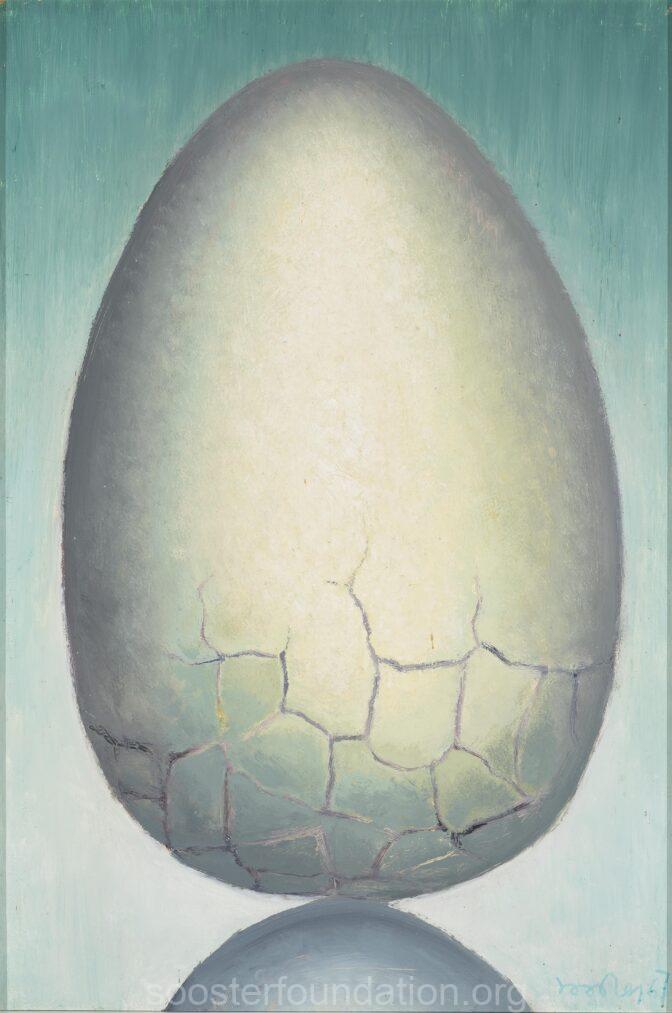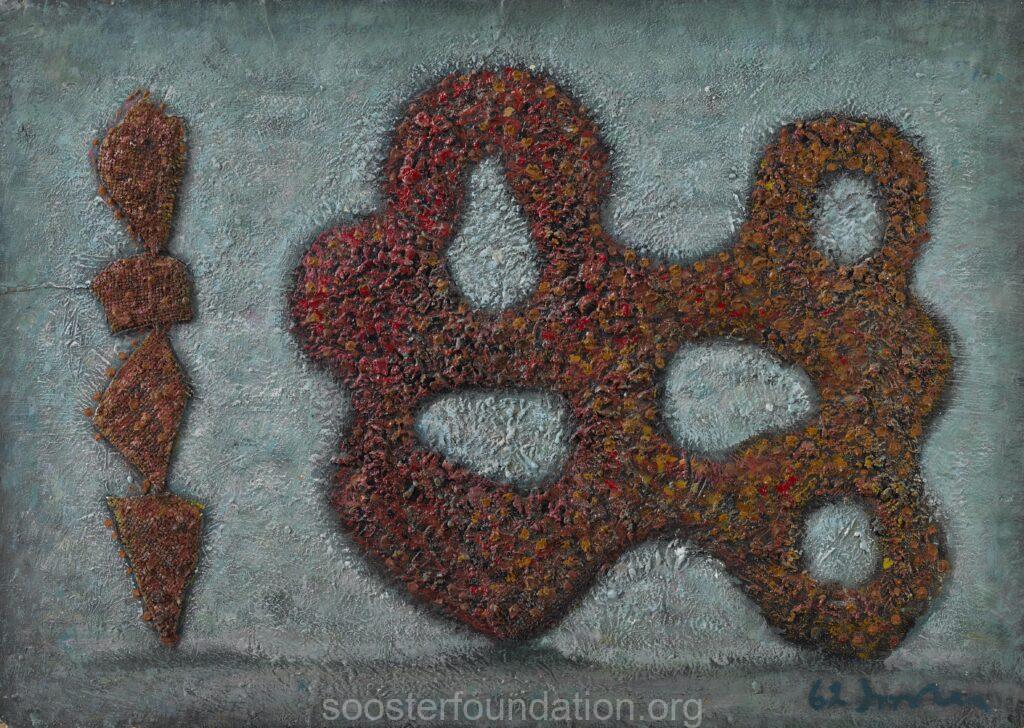Юло Соостер в поиске индивидуальности, творческих методов и художественных средств

Ülo Sooster (1924–1970) is one of the key figures in Estonian art of the second half of the 20th century. His charismatic personality, rich and multifaceted artistic heritage – working in-depth with surreal and abstract imageries to outline some of his main interests – as well as novel-worthy biography with such milestones as political imprisonment, great love, life outside his homeland and early death, makes him a true legend. Belonging both in the history of post-WWII Estonian modernism and the non-official Moscow art of the 1950s and 1960s that sprouted Moscow conceptualism, Sooster’s case needs revision especially nowadays, when the critique of colonial aspects of Soviet art history is an important agenda.
Born and raised on a farm on the Estonian island of Hiiumaa, Sooster studied at the Higher Art School Pallas (from 1944 the Estonian SSR Tartu Art State Institute) from 1943 to 1949. He therefore inherited the values of the first decades of the Republic of Estonia – connection to the traditional culture, a bond with nature and agriculture, and, though already fading under Sovietisation, dialogue with modernism and developing an original art and visual culture relevant for a young European country of the time. In the 1940s, the Tartu school of painting was cultivating modest late impressionism, and trying to adjust, however rather formally, to the canons of Socialist Realism, but students still had access to books and journals on modern art, both in public and private collections. In this context, Sooster was still able to study the history of more radical 20th century art through books, becoming acquainted with the work of cubists or surrealists already as a student. This, as well as the vivid intellectual life and French-oriented café culture in the university city of Tartu, undoubtedly formed a particular way of thinking, which created the basis for his later art practice.
Unfortunately, Sooster did not have much chance to develop his artistic ideas and career after graduating. Soon after moving from Tallinn in search of a job, he and a group of co-students and friends from Tartu were accused of anti-Soviet activities, so he spent the years 1949–1955 in labour camps in Kazakhstan.1 After being released, the fact that he had been a political prisoner was a serious obstacle in publicly re-establishing himself as an artist in Estonia. Having married Lidia Serkh, whom he had met in the labour camp complex, Sooster left for his wife’s hometown of Moscow, and it was there that he became the artist we know today. There, his creative ideas developed in a fruitful environment, in an alternative community of artists, writers, musicians, researchers in humanities and scientists – whom Lidia Sooster has described as the creators of a true cultural revolution. However, the inner freedom of this circle was in stark contrast to the severely restricted official art, controlled by the Artists’ Union officials. Khruschev’s Thaw wasn’t as mild as one might imagine. The way the intelligentsia’s hopes were crushed is perfectly exemplified by the notorious conflict between the Soviet Communist Party leader and the non-conformist artists of Sooster’s circle (Ernst Neizvestnyi, Vladimir Yankilevsky, Yuri Sobolev, Ely Bielutin and members of his studio, etc.) at the exhibition 30 Years of the Moscow Artists’ Union at the Manege in 1962.

Therefore, Sooster’s participation in official exhibitions during his lifetime was rather the exception and his works were known to a relatively small though highly professional audience. Still, his influence on other artists is considered essential: for instance, one of the leaders of Moscow conceptualism and the later international art star Ilya Kabakov has referred to Sooster as his teacher. Kabakov also organised their joint exhibition in the UK in 19922 and authored the first monograph of Sooster’s oeuvre.3 Of course, Sooster influenced not only artists in Moscow, but also those in Estonia. His studio became a sort of pilgrimage destination, visited by friends from art school – the Tartu circle of artists including Valve Janov, Heldur Viires, Kaia Kärner etc.4 – as well as artists of the younger generation, namely the group known as ANK ’64 from Tallinn, who repeatedly visited him from the mid-1960s onwards. For Estonian artists, such trips to Moscow were significant, as in addition to visiting the studios of Sooster and his friends, it also gave them the opportunity to visit exhibitions and provided them with access to art related literature in libraries and antique shops, through which more alternative information on both historical and modernist art was seeping into the Soviet Union.
However, this dynamic did not develop only in the direction of Moscow. Sooster visited his circle of friends in Tartu too, discussing art and creative methods, and the exchange of ideas was mutual. In addition, Sooster organised meetings between the Tartu circle and the members of the ANK group, facilitating communication between different generations and groups of innovative artists in Estonia. Artists from Moscow also came to Estonia to see the most radical works by artists in Tartu and Tallinn in their studios, but to also enjoy what was felt to be the Soviet “West”, where the official cultural life was more liberal and, due to proximity to Finland, more informed about contemporary developments outside the Soviet Union. Therefore, a cultural bridge between Moscow and Estonia was established and this cultural exchange continued even after Sooster’s death, into the 1970s and 1980s, fading only after the collapse of the USSR. After gaining independence, each nation was preoccupied with the construction of its own new identity as well as establishing contacts with the rest of the world, previously hidden behind the Iron Curtain.


Therefore, Sooster had a multiple or hybrid identity – a kind of trickster, who was everywhere but fully belonged nowhere. In Moscow, he was perceived as a foreigner because of his accent and habits, such as smoking a pipe and sketching in a café. However, when it comes to Estonia, he might have felt it was too provincial, although he did miss his homeland and it was the inspiration for his cryptic world of symbols, which included the fish, the sea, the egg and the juniper. Sooster’s identity as an artist was also hybrid because he did not focus on one aesthetic-philosophical system but simultaneously worked with very different visual and conceptual approaches – from the absurd of surrealism to the estrangement of metaphysical painting, from the deformation of cubism to the expressiveness or constructed analytical nature of abstractionism. In Moscow, with his close friend and colleague Yuri Sobolev, Sooster continued his research of modern art – not only playing with many of its methods in his work5 but also using it to develop his own original pictorial system. Alongside Sooster’s refined illusionist oil paintings, his heritage includes uncountable ink drawings and sketches – a true explosion of ideas and potential approaches, which demonstrates his ability to both think as quickly as he was drawing single lines and to work consistently on one single image, forming it layer by layer with brushstrokes.


Sooster’s hybridity extends to the artistic media he worked in; for example, book illustration was not only his main way of earning a living, but also, to a degree, a platform for experimenting with new ideas. Unlike his paintings and drawings, books illustrated by him enjoyed a much wider audience during his lifetime, as Soviet publishing culture included enormous print runs. Good examples are Sooster’s illustrations for popular science books and articles,6 as well as for science-fiction – both spheres where processes that are often unreachable to the human eye were discussed, making it possible to explore ingenious surreal or abstract images, which would have met more severe criticism in the format of exhibition art. Unlike Moscow conceptualists, like Kabakov or Viktor Pivovarov, who incorporated the school-bookish visual language of Soviet children’s literature ironically into their artworks, Sooster had a more emphatic attitude, where fascinating dialogues between artistic and non-artistic imagery could be seen. On the one hand, he transferred elements from his scientific and science-fiction illustrations into his paintings and drawings, thus enriching the vocabulary of the visual art of the time. On the other hand, he used structures or atmospheres of historical and modernist artworks to visualise processes described in research papers by particle physicists or in fantastic literary narratives. Thanks to his book illustrations, Sooster’s ideas circulated in the wider literary and visual culture.
It is essential to retell stories; however, in the context of art history, it is also important not only to remember the initial narrative but to also revise it according to newer knowledge. Today, it is important to acknowledge Ülo Sooster as an artist of multiple identities and multiple mutual influences, which also define his uniqueness. While Sooster’s artistic dialogue and field of influence in the Estonian context has been researched rather extensively, its Moscow counterpart still needs comprehensive research, as it tackles questions of the Russian-centred discourse of Soviet art. Being simultaneously acknowledged and at times half-forgotten cornerstone to many important processes in the art of his time, and not only in the Soviet context, Sooster definitely deserves greater international attention.

NOTES
- [1]Paradoxically, the inhuman experience of imprisonment saved Sooster from the period of the harshest Stalinist repressions in Estonian art, so his modernist endeavours were preserved unbroken by cultural authorities.
- [2]Ülo Sooster, Ilya Kabakov: Illustration. A Way to Survive. 14.04.–30.05.1993, Ikon Gallery, Birmingham.
- [3]Ilja Kabakov, Ülo Soosteri piltidest: subjektiivseid märkmeid = О картинах Юло Соостера: субъективные заметки = On Ülo Sooster’s Paintings: Subjective Notes. Tallinn: Kunst, 1996.
- [4]See in detail: The Tartu Circle and Ülo Sooster. Addenda to Soviet-Era Art History I. Ed. Liisa Kaljula. Tallinn: Art Museum of Estonia, 2014.
- [5]Here, such names as Pablo Picasso, René Magritte, Max Ernst, Giorgio de Chirico could be brought out.
- [6]Mainly commissioned by the publishing Znanie [Knowledge] and magazine Znanie – Sila[Knowledge is Power].
ELNARA TAIDRE is an art historian, critic and curator. She works as head of the graphic arts department at the Art Museum of Estonia.